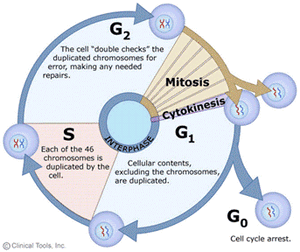Cell cycle and its regulation
The Cell Cycle
DNA replication takes place during interphase, a phase of the cell cycle characterized by significant cellular activity. The cell cycle, a cyclic alternation between mitosis and interphase, occurs in all tissues with cell turnover and consists of four distinct phases: G1 (the gap between mitosis and DNA replication), S (DNA synthesis), and G2 (the gap between DNA duplication and the next mitosis).
- During the G1 phase, there is active synthesis of RNA and proteins that regulate the cell cycle. Additionally, the cell volume, which is reduced by previous mitosis, increases to its previous size.
- In the S phase, DNA and histones are synthesized, along with the duplication of the centrosome.
- During the G2 phase, proteins required for mitosis accumulate. Postmitotic cells may begin to specialize and differentiate, leading to temporary or permanent suspension of cell cycle activities, referred to as the G0 phase.
Regulation of the cell cycle involves signals from the extracellular environment, such as mitogens or growth factors, which trigger cycling in post-mitotic cells (bypassing the G0 state). Nutrients and proteins necessary for DNA replication accumulate, and when conditions are favorable (at the restriction point), DNA synthesis initiates. Progression through each phase of the cycle is controlled by specific proteins, including cyclins and cyclin-dependent kinases (CDKs).
The cell cycle progression is also regulated by various signals that halt cycling under adverse conditions, such as DNA damage, which triggers DNA repair mechanisms. If the issue at any checkpoint cannot be corrected while cycling is halted, tumor suppressor genes or proteins, such as P53, are activated, redirecting the cell's activity towards apoptosis. Mutations in the gene encoding P53 are often observed in cancer cells, compromising the cell's ability to detect and repair damaged DNA.
Apoptosis
Apoptosis, also known as programmed cell death, is a highly regulated cellular process that results in the production of small membrane-enclosed apoptotic bodies. These bodies are swiftly engulfed by neighboring cells or specialized macrophages responsible for debris removal.
An illustrative example of apoptosis occurs within the thymus, where T lymphocytes potentially reactive against self-antigens receive signals activating the apoptotic program, leading to their demise before exiting the thymus.
Apoptosis serves as a crucial mechanism for eliminating cells whose survival is impeded by factors such as nutrient deprivation, damage from free radicals or radiation, or the actions of tumor suppressor proteins.
The process of Apoptosis involves several steps:
1. Loss of mitochondrial function: Cytochrome C is released into the cytoplasm, where it activates proteolytic enzymes known as Caspases.
2. Fragmentation of DNA: Endonucleases become activated, cleaving DNA between nucleosomes into small fragments.
3. Shrinkage of nuclear and cell volumes.
4. Formation and subsequent phagocytic removal of the apoptotic bodies.

